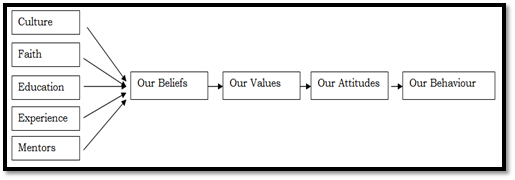(1)(1)(1)-1631703887569.jpeg)
EDEN BLOGS
ATTITUDE: CONTENT, STRUCTURE, FUNCTIONS| ETHICS CONCEPT SERIES
(1)(1)(1)-1631703887569.jpeg)
(1)(1)(1)-1631703887569.jpeg)
ATTITUDE
An attitude is a relatively enduring organization of beliefs, feelings, and behavioral tendencies towards socially significant objects, groups, events, or symbols. It is a learned tendency or predisposition to respond in a consistently favorable or unfavorable manner for a given object.
Gordon All port once described attitudes as “The most distinctive and indispensable concept in contemporary social psychology”. Attitudes can be of various types like explicit and implicit attitudes, positive and negative attitudes, Moral and Political Attitudes, democratic attitudes, Bureaucratic Attitudes etc.
As the Attitude forms the very basis of one’s behaviour people can feel one’s attitude although they may hear the words Attitudes are formed primarily based on underlying values and beliefs as shown in the figure below.
ATTITUDE CONTENT
Carl Jung, one of the founders of psychoanalysis, is of the opinion that the contents of the conscious and unconscious part of the mind are usually different. Accordingly, attitudes are classified as explicit and implicit.
- Explicit Attitude (Conscious) – If a person is aware of his attitudes and how they influence his behaviour, then those attitudes are explicit. Explicit attitudes are formed consciously.
- Implicit Attitude (Sub-Conscious) – If a person is unaware of his attitudes (beliefs) and how they influence his behaviour, then those attitudes are implicit. Implicit attitudes are formed subconsciously.
ATTITUDE STRUCTURE
The Structure of Attitude consists of three major components: Cognitive, Affective and Behavioral. This multi-component model of attitude structure is known as the ABC Model or CAB Model. Let’s see the components of the CAB model.
- Cognitive Component: Cognitive part consists of a person’s thoughts and beliefs about the object. This involves the person’s learning, knowledge, beliefs, and thoughts about the attitude-object (in our case, Honda cars). For example, if you have learned previously that Honda car give more than 20 km/liter mileage on petrol – that can create a positive attitude towards the brand.
- Affective Component: The Affective component consists of the feelings which the object, person, issue or event evoke. This is also known as emotional component. For example, if owning a Honda car gives you pleasure and prestige that will create a positive attitude about the brand.
- Behavioral Component: The behavioral component consists of the manner in which the attitude influences a person’s behaviour. This involves the past behaviors or experiences regarding the attitude object. For example, if you have previously owned or driven Honda cars and felt comfortable driving the same, that will create a positive attitude towards the brand. People hate cognitive dissonance, and hence try to align the present behaviour with past behaviour as well.



{{doubts.user.firstName}}
{{doubts.createdAt | formatDate}}kunal
{{'' | formatDate}}Other sources of attitude formation :